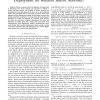Free Online Productivity Tools
i2Speak
i2Symbol
i2OCR
iTex2Img
iWeb2Print
iWeb2Shot
i2Type
iPdf2Split
iPdf2Merge
i2Bopomofo
i2Arabic
i2Style
i2Image
i2PDF
iLatex2Rtf
Sci2ools
105
Voted
INFOCOM
2006
IEEE
2006
IEEE
Is Deterministic Deployment Worse than Random Deployment for Wireless Sensor Networks?
— Before a sensor network is deployed, it is important to determine how many sensors are required to achieve a certain coverage degree. The number of sensor required for maintaining k-coverage depends on the area of the monitored region, the probability that a node fails or powers off (to save energy), and the deployment strategy. In this paper, we derive the density required to maintain k-coverage under three deployment strategies: (i) nodes are deployed as a Poisson point process, (ii) nodes are uniformly randomly distributed, (iii) nodes are deployed on regular grids. Our results show that under most circumstances, grid deployment renders asymptotically lower node density than random deployment. These results override a previous conclusion that grid deployment may render higher node density than random node distributions.
Related Content
| Added | 11 Jun 2010 |
| Updated | 11 Jun 2010 |
| Type | Conference |
| Year | 2006 |
| Where | INFOCOM |
| Authors | Honghai Zhang, Jennifer C. Hou |
Comments (0)

